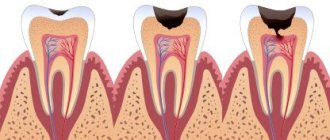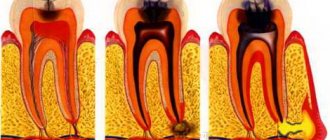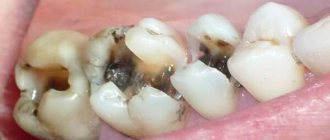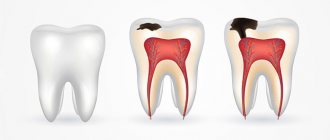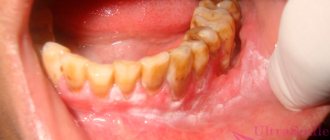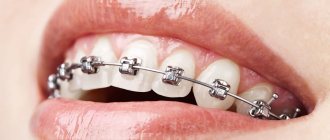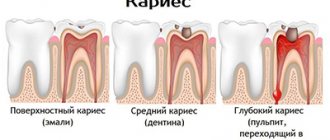Filling is the most common way to restore the shape and function of a tooth destroyed due to caries. If this procedure is done on time, you will be able to avoid more serious dental interventions and preserve your natural teeth. It happens that fillings fall out due to natural wear or something provokes the destruction of the filling material ahead of schedule. The main thing for the patient is to promptly pay attention to the absence of a filling, and even better to prevent this phenomenon, which only in the eyes of a layman is harmless and harmless.
Signs of a filling falling out soon
How can you tell if a filling has fallen out? This is quite simple - at the place of its installation there is no material with which the filling was made, and there is a hole. Therefore, it is better to prevent such a phenomenon and contact a specialist in advance, even before complete loss.
Determining that the filling does not stay in the tooth and will soon fall out is also quite simple. Gaps appear between the tooth surface and the filling material, which are almost invisible at first, but become larger over time. The material itself becomes loose. This is felt when you press the seal with your tongue. If such phenomena are observed, you should immediately consult a doctor so as not to be annoyed later that the filling has come out.
Question No. 7: is it possible to put the filling in place yourself?
The filling fell out. What else should you do before seeing a doctor? To protect the resulting cavity from bacteria and food, you can close it yourself using a piece of cotton wool or a bandage. However, such a protective barrier will have to be changed quite often. This should be done after every snack, tea or meal. Additionally, you need to rinse your mouth with antiseptics (for example, Miramistin), herbal decoctions (chamomile and sage are suitable), and a soda solution. But you shouldn’t think about making a homemade filling, or even more so gluing it. By doing this you can only aggravate the situation and cause tissue damage or infection.
Necessary actions if a filling falls out
It is important to know what to do if a filling falls out. It is advisable to immediately make an appointment with a dentist, but in some cases it is not possible to urgently visit a doctor. When a filling has come out of a tooth, you can do without it for a short time, but only for a certain time.
If treatment is delayed, the tooth may become infected, leading to acute pain and gradual destruction. It is important to visit a specialist in a timely manner, regardless of whether the filling is permanent or temporary.
But it is better to avoid such a situation and visit the dentist at the stage of loosening. Any gap or even minimal gap between the tooth and the filling is a place for bacteria to enter.
And if you don’t pay attention to such a problem in time, then you shouldn’t be surprised that the filling has fallen out between the teeth.
Most often, such troubles occur with molars. They experience a lot of stress and the filling material can be destroyed if you often eat solid foods. Fillings on the front tooth fall out much less frequently.
Reasons why fillings fall out
Why did the filling fall out? There are many reasons why fillings may fall out; in this article we will look at the most common ones.
Technical. Technical reasons include an incorrectly installed seal, poorly selected material for its manufacture, as well as its quality. If the filling is the wrong size (larger or smaller), it may fall out earlier. Most often, this problem occurs when a filling is placed under the crown of a tooth. The patient puts off visiting the dentist for a long time; as a result, the filling simply does not match the size of the crown.
Size of the sealed area. The larger the carious cavity, the higher the risk of a part of the tooth breaking off, naturally along with the filling.
Temporary filling. Temporary, in fact, that’s why it’s called it, since it’s not intended for permanent wear. You can wear such a filling only for a few weeks, a maximum of a month, then it is replaced with a permanent one. Ignoring the norms and avoiding installing a permanent filling leads to expansion of the affected area.
I have come to the end of the lines of service. As mentioned above, the service life of a filling installed by a professional dentist can exceed 20 years, while the warranty period varies between 5-7 years. A properly installed filling will fall out after about this time, in certain cases due to greater wear and tear sooner.
Failure to comply with treatment standards. Poor treatment of the area to be filled, poor contact of hard tooth tissues with the filling material, insufficient depth of treatment of the canal - all this leads to the inevitable loss of the filling. If not today or tomorrow, then definitely in the near future. The worst thing happens when inflammatory processes begin to occur under the filling, this can cause severe pain. The problem can only be corrected by removing the poorly applied filling solution, additional treatment of the carious lesion, followed by re-application of the filling.
Individual characteristics of the structure of teeth. The strength of enamel and dentin varies from person to person; its condition is influenced by many factors, such as poor environment, excessive consumption of acidic foods, internal infections, hereditary diseases, as well as defects in the development of teeth during the prenatal period. In this case, the filling service line for each person will be individual.
Poor care. Insufficient oral care, as well as the general condition of the body, can negatively affect fillings. Proper care of your teeth and oral cavity in general is a guarantee that your fillings will last you as long as possible. Poor hygiene reduces the warranty period of the seal by approximately 60-70%. Also, improper dental care can include frequent consumption of excessively hard foods, as a result of which a piece of the tooth or filling may break off; in some cases, the filling falls out completely.
Pain after a filling falls out and other unpleasant consequences
Simple recommendations for patients on what to do when a filling falls out and a tooth hurts:
- You need to rinse with a solution of baking soda and salt.
- You can take a painkiller, it could be Ketanov or Analgin.
- During the inflammatory process, the temperature may rise. It must be knocked down after exceeding 38.5° C. For this, antipyretics are used.
- If there is bleeding from a tooth, you should immediately consult a doctor. There can be many reasons for this phenomenon, and it will be possible to accurately determine the possible problem only after an appropriate examination.
You can find many tips on how to numb a tooth at home, but the most effective option is to rinse and take appropriate medications.
When a filling with arsenic falls out, you need to carefully remove the remaining medication with a cotton swab and rinse the tooth cavity with a soda solution.
Expanding indications for tooth filling
Many patients are surprised, and some are even outraged, by the dentist’s statements about the need to restore the tooth with a more reliable structure - a crown or inlay (onlay) instead of a filling. Misunderstanding leads to suspicion of the doctor of incompetence or of a “scam” for an expensive restoration. “Why can’t you build up a tooth with a filling?” — Those who previously had a filling in the same place for several years are sincerely indignant, especially. It comes to the point that the patient runs away to a neighboring clinic, where the “kind” doctor saves his tooth from having a crown (sometimes charging an amount for “building up” or “artistic restoration” that is not much different from laboratory restoration), and then, two years later, a filling falls out or breaks off again.
There are medical indications and contraindications. They do not depend on the wishes of the doctor or patient. For fillings, the indication for installation is minor tooth decay. As a first approximation, we can say: insignificant - this is less than half the volume of the crown part of the tooth (although in reality everything is somewhat more complicated - the area of the lost chewing surface is taken into account, whether the cusps or cutting edge are affected, whether caries extends under the gum, how difficult it is to restore contact points, etc. .). If the tooth is more damaged, a filling is contraindicated. Of course, you may be lucky and an extensive filling will remain on the tooth for many years, but retention in the tooth is not the only requirement for a filling. It must also restore chewing function, have a tight contact point (so that food does not get stuck between the teeth), etc.
The loss of the “seal on the pin” is a direct consequence of violations of the indications. At a minimum, the “filling on the pin” should be covered and protected by an artificial crown, and at maximum, the tooth may have been so destroyed that it was contraindicated to preserve it even then, before pinning.
Why do some dentists follow the patient’s lead and make his dream of growing a tooth without a crown come true, while others are stubborn and refuse to do so? No, not because the former are good, and the latter are evil and greedy. It’s just that the “rescuers of hopeless teeth” agree to the “tuft of wool”, only the patient stayed and did not run away to another doctor. In addition, fillings and crowns are often done by different specialists: a general dentist and an orthopedic dentist, respectively. Moreover, the treatment of caries is the domain of the therapist; he does not always want to send the patient to another specialist, depriving himself of his daily bread. This is where the fillings are made. Even for the entire tooth, any volume of filling can be sculpted.
In case of small chips of enamel on the cutting edge, the fillings do not hold well. In this case, filling is also contraindicated, but instead, you can simply grind the enamel without restoring anything.
Is it possible to close a hole in a tooth yourself?
The question often arises as to what can be used to seal a temporarily opened cavity if a filling falls out. People use a wide variety of materials for these purposes - from cotton wool to chewing gum, in general - everything that can be used to fill a hole at home. Under no circumstances should this be done. Before you tape a tooth, you should think about the consequences. The cavity will not be closed hermetically, which means food debris and bacteria will get into it.
Before you think about how to plug a tooth at home, it is worth considering that any material will create extremely favorable conditions for the proliferation of microbes and the occurrence of infection or inflammation. Therefore, the question of how to cover the tooth should not arise. To avoid the accumulation of food debris in the cavity, it should be rinsed regularly at least 6-7 times a day.
Excessive load
Mechanical trauma, of course, can cause not only the filling to fall out, but also the entire tooth. But less obvious, but more insidious situations should also be noted. For example, several years ago a filling was made from good material, in full compliance with the technology, strictly according to the indications, and over these years changes have occurred in the oral cavity - other teeth have been removed. If prosthetics did not follow, then the same filling began to work not only for itself, but also for absent neighbors. This increases the load on it and the risk of falling out.
Treatment process
People faced with such a problem are interested in how the tooth will be treated when the filling has fallen out. It all depends on individual characteristics, so it is worth considering the most common situations.
If the carious cavity is too large, it makes no sense to fill it again. The material will not hold and will fall out again after a short time. Therefore, the doctor will suggest alternative methods of eliminating the defect, most likely installing a crown.
If repeated caries occurs, pulpitis or other diseases develop, they must first be cured. The doctor prescribes and carries out all the necessary measures and, after complete recovery, places a new filling. If the filling material falls out of a pulpless tooth, re-filling is often also ineffective. In this case, the specialist will recommend installing a pin.
Methods for restoring the integrity of a tooth depend on its condition, so it is difficult to suggest a treatment plan without a preliminary examination.
The most common materials from which permanent fillings are made
In any situation, the material is selected based on the patient’s key requests and financial capabilities. A fallen filling can be replaced with a similar material or any other type of product.
Before placing a filling on a tooth, you should definitely familiarize yourself with the advantages of certain materials:
Metal. The main disadvantage of such fillings is the mercury contained in the composition, which is harmful to the body. Most often, metal fillings are used on chewing teeth, as well as in the case of subgingival defects. Often, restoring a tooth with a metal filling is recommended in situations where aesthetic appeal is not important (for example, under a crown).- Glass ionomer cement. This filling has an excellent marginal fit and is low in cost. Thanks to special additives, dental tissues are nourished with fluoride ions, which prevents caries from developing again. However, such fillings are very fragile.
- Cement. Products based on powder and special liquid also prevent the formation of repeated caries, but are not durable, as they are made from fragile material.
- Composites. Products that replaced cement filling materials. Composites differ from plastics in their filler. Composites are acrylic-containing, light-curing and epoxy resin-based.
- Light composites. Such fillings are also called photopolymer fillings. This is the most popular and popular type of material for creating dental fillings in our country. Such fillings are distinguished by their aesthetic appeal, strength and durability. In addition, photopolymer fillings are distinguished by a wide range of colors and the possibility of polishing.
Lost temporary filling
What to do when a temporary filling falls out? It is placed to fix the medicine in the tooth cavity and prevent the entry of saliva, food debris and microbes. Arsenic, which is poisonous, is used as a medicine. Therefore, if such a situation arises, a number of measures need to be taken:
- carefully examine the tooth cavity and determine whether the medicine remains there;
- if it remains, carefully remove it with a cotton swab;
- make a warm soda solution (at the rate of 1 teaspoon of soda per glass of water);
- rinse the tooth cavity thoroughly.
When the canals are sealed, the loss of a temporary filling does not cause significant discomfort, but leaving the tooth as is is prohibited. It can be destroyed under the influence of various factors. For a filling to fail, there must be significant reasons and only a specialist can eliminate them.
If a filling with arsenic falls out immediately after visiting a specialist, you need to make a second appointment as soon as possible and have it restored. If there are several days left until the next scheduled appointment, you don’t have to reschedule it and visit the doctor when it’s scheduled. Only a dentist can tell you how long you can walk without a filling, so it’s a good idea to call and get a consultation.
Prevention
A number of recommendations will help keep your teeth fillings in good condition. The first step is to carefully choose a dentist who will provide adequate treatment, prepare the tooth cavity and select high-quality filling compounds. In the future, everything will depend on the patient, who is obliged to take care of his teeth. Do not expose them to rough influences and carefully, but delicately, carry out oral hygiene procedures. And the main thing is to visit the dentist regularly, even if nothing worries you. Damage to a filling cannot always be felt at an early stage. And timely medical care will prevent more serious treatment, which may be needed if the filling fell out a long time ago.
Loss of fillings in children
When a child’s filling falls out, you should not ignore the problem, even if the teeth are baby. Caries and other diseases can provoke severe pain and the development of an inflammatory process.
What to do if a temporary filling falls out of a baby tooth:
- Call your doctor, consult and make an appointment as soon as possible.
- Ensure that your child maintains good oral hygiene.
- Rinse your teeth regularly to remove food debris.
Important! Fillings on baby teeth fall out for various reasons, and only a specialist can determine what causes this phenomenon. So, in any case, you cannot do without a visit to the dentist.
A filling fell out, my tooth hurts, what should I do?
If your tooth is sensitive after losing a filling, you most likely have open dentinal canals. Dentin canals are tiny connections between the dentin and the pulp of your tooth.
Since the only sensation that the nerves in the pulp can send to your brain is pain, without a filling, your tooth may react quite painfully to hot and cold drinks and food. Over-the-counter pain relievers may help relieve this pain (check with your doctor).
A temporary solution to stop the source of pain can be ordinary cotton wool. Since the pain is caused by open dentin canals, you can try to temporarily close them until you see your dentist. Close the dentinal canals in the exposed area of the tooth by temporarily filling it with cotton wool.
Filling falling out during pregnancy
When a temporary filling falls out during pregnancy, this is a reason to urgently consult a dentist. Many women worry that treatment may negatively affect the course of pregnancy. Women carrying a child are certainly at risk, but doctors are well aware of the acceptable limits of exposure. If necessary, the doctor will select the optimal method of intervention so as not to harm the body.
You need to treat your teeth anyway. Carious lesions are an ideal environment for the development of pathogens that can cause much more harm to a pregnant woman than the process of restoring a diseased tooth.
If a filling falls out at the end of pregnancy - in the 3rd trimester, the doctor may postpone treatment if serious intervention is necessary to restore the tooth. In most cases, the specialist will make do with minimal temporary treatment, and will carry out complex measures carried out under anesthesia after childbirth.
Stock
-10%
Dental restoration All-on-4 RUB 310,000.
280,000 rub.
get -62 %
Metal-free dental crown made of zirconium dioxide 25,000 rub.
9500 rub.
get -11 %
Segment of chewing teeth with prosthesis on day 3 135,000 rub.
120,000 rub.
get -16 %
Premium implantation Nobel and zirconium dioxide crown 125,000 rub.
105,000 rub. get
Destruction of the seal
Has the filling broken? This is evidence of its gradual destruction. This phenomenon can occur for various reasons. The main ones:
- Too much zeal when carrying out hygiene procedures. Frequent use of a hard brush can cause damage to the filling material or enamel.
- Large loads on the tooth. They occur when eating solid foods, seeds, nuts and the like.
- Poor quality filling material.
- Failure of a specialist to comply with the technological process.
What to do if a piece of the filling breaks off and your tooth hurts? This indicates that the material does not adhere tightly to the surface and a gap has arisen between the filling and the tooth. Pain is a consequence of the inflammatory process. If the pathology is not eliminated, it will develop and cause various diseases.
If a filling breaks on a dead tooth, a crown will have to be placed in any case. If a problem arises on a front tooth that is still alive, the doctor will suggest depulping it and then installing a crown as well.
Question No. 9: what should be done to make the restoration last as long as possible?
The first rule is to choose a professional doctor who will provide quality treatment and install the filling correctly.
The second rule is to avoid chewing too hard foods with the treated tooth, as well as chewing gum and sticky sweets.
The third rule is to be sensitive and attentive to the slightest changes in the condition of the filling material and the treated tooth itself. If you suspect that the restoration will soon fall out, do not delay contacting a doctor. Well, in principle, do not forget to visit the dentist once every six months - to maintain the guarantee and assess the condition of the teeth in principle.
Notice
: Undefined variable: post_id in
/home/c/ch75405/public_html/wp-content/themes/UltraSmile/single-item.php
on line
45 Notice
: Undefined variable: full in
/home/c/ch75405/public_html/wp-content /themes/UltraSmile/single-item.php
on line
46
Rate this article:
( 4 ratings, average: 4.50 out of 5)
dental fillings
- Kostina I.N., Nikolaeva A.A. Arsenic necrosis of the jaw: complications in the treatment of dental pulpitis. Problems in dentistry, 2010.
Expert “If the tooth is severely damaged, more than half of the crown, then it is necessary to evaluate the feasibility of re-installing the filling. It may be better to install a crown or stump, or strengthen the root on a pin - these solutions will allow you to restore the anatomy and functionality of the damaged area.” Dentist-therapist Tatyana Vitalievna Varlamova
Consulting specialist
Varlamova Tatyana Vitalievna
Specialization: Dentist-therapist Experience: 5 years
Tip #1: Rinse your mouth thoroughly
If a temporary filling came out, then most likely there was a medicine underneath it (preparations based on calcium hydroxide, antibiotics, antiseptics and antimicrobial agents1), the purpose of which was to influence the diseased tooth and its canals from the inside. Under the filling materials there may also be a devitalizing paste based on arsenic.
It is important to rinse your mouth thoroughly
Medicines are covered with temporary materials not only so that they cannot leak out or be washed out by saliva and liquid, but also to protect the body from possible negative effects. For example, the same arsenic is toxic; after ingestion, it can cause poisoning, gastrointestinal upset, an allergic reaction and a rash. If the medicine comes out of the cavity and gets on the mucous membrane, this can lead to tissue irritation or burns.
To prevent the spread of medicinal compounds to the mucous membranes and their ingestion, thoroughly rinse the mouth with any antiseptic solution (for example, Chlorhexidine).
If a temporary filling falls out while eating food, do not swallow the food that was in your mouth at that moment, but rather spit it out.
Continued action of the etiological factor that caused tooth decay
In case of caries, a filling not only restores lost tissue, but also prevents its further progression (if placed correctly). With a wedge-shaped defect, this does not always happen. Nevertheless, often a filling is the optimal way to solve the problem for some time with this disease. This is exactly the case when the dentist may not be at fault, and such a nuisance should be taken calmly. For more details, see Treatment of wedge-shaped defect.

